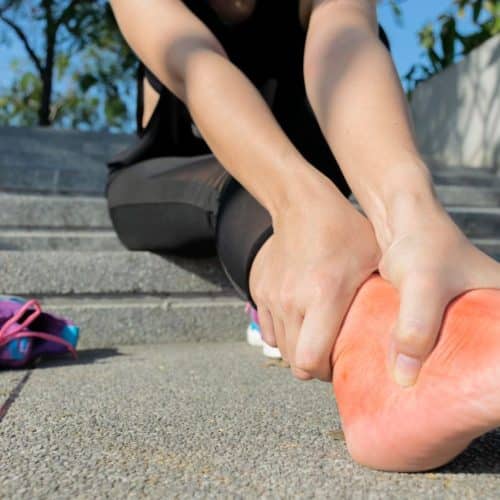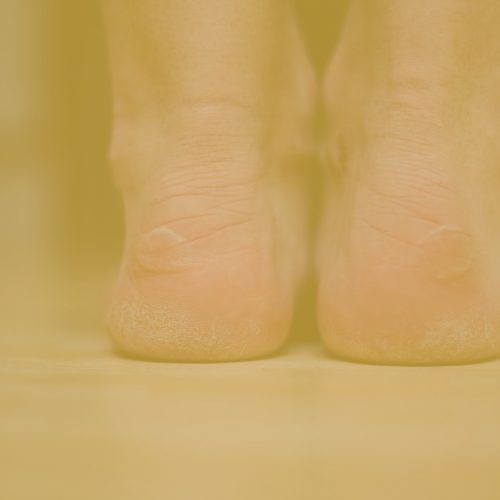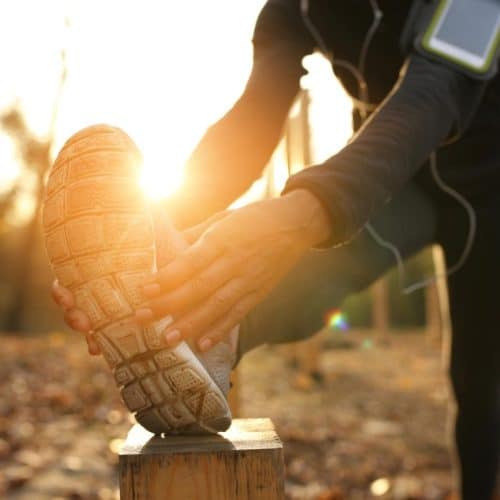Plantar fasciitis is a very prevalent foot condition that affects a large number of people all over the world. This illness, characterised by a sharp, stabbing pain in the heel, can be debilitating and cause difficulties in day-to-day tasks. To our good fortune, there are a number of therapies and preventative strategies that have proven to be highly successful. This article will discuss the factors that might lead to plantar fasciitis, its symptoms and possible remedies.
What is Plantar Fasciitis?
Plantar fasciitis is one of the most common causes of heel pain, affecting millions yearly. The condition is named after the plantar fascia, a thick, web-like ligament that connects the heel to the front of the foot. This ligament acts as a shock absorber, supporting the arch of the foot and playing a crucial role in walking and running.
When the plantar fascia undergoes excessive strain or stress, it can develop tiny tears, leading to inflammation and pain. This strain can be caused by various factors, from biomechanical imbalances in the foot to external factors like the type of footwear one uses.
The pain associated with plantar fasciitis is often described as a sharp, stabbing sensation, primarily felt at the base of the heel. It can also extend along the sole. The pain is typically most intense after rest periods, such as upon waking up or after sitting for an extended time. This is because the plantar fascia contracts and tightens when at rest, and sudden stretching upon standing can cause pain.
It’s essential to understand that plantar fasciitis is not just a foot discomfort. If left untreated, it can alter an individual’s walking pattern, leading to knee, hip, and back issues. Moreover, the condition can become chronic, challenging daily activities and reducing the quality of life.
While the exact cause of plantar fasciitis can vary from person to person, some common culprits include prolonged standing, walking, or running on hard surfaces, wearing unsupportive footwear, or having specific foot structures like flat feet or high arches. It’s a condition that can affect anyone, from athletes to office workers, making it essential to be aware of its symptoms and potential treatments.
Symptoms of Plantar Fasciitis
Plantar fasciitis manifests in a variety of symptoms, with the primary being a sharp, stabbing pain in the heel. However, the intensity and occurrence of this pain can vary based on activity and time of day. Here’s a deeper dive into the specific symptoms:
- Morning Pain: One of the hallmark symptoms of plantar fasciitis is pain experienced during the first few steps after waking up in the morning. As the plantar fascia ligament contracts and tightens overnight, the sudden stretching when you stand up can cause sharp pain. This pain usually decreases as the foot limbers up with more movement but can persist in severe cases.
- Pain After Prolonged Rest: Similar to morning pain, individuals with plantar fasciitis often feel discomfort after sitting or lying down for extended periods. When the foot is at rest, the ligament contracts and the sudden stretching upon standing can trigger pain.
- Pain When Climbing Stairs: The action of climbing stairs puts added stress on the heel and arch of the foot, exacerbating the pain of plantar fasciitis. This is especially true when ascending as the foot pushes off from a step.
- Pain After Intense Activity: While some people with plantar fasciitis experience pain during physical activity, many feel it afterwards. This post-activity pain can be attributed to the inflammation and stress placed on the ligament during the activity.
- Tenderness in the Heel: Apart from the sharp, stabbing sensation, the heel’s base (where the plantar fascia attaches) can be tender to touch. This tenderness can be more pronounced in the morning or after rest.
- Stiffness: Some individuals report stiffness in the foot’s arch, making flexing or standing on tiptoes challenging.
It’s crucial to note that while these symptoms indicate plantar fasciitis, they can also be associated with other foot conditions. Therefore, a proper diagnosis by a healthcare practitioner is essential to ensure appropriate treatment.
Causes and Risk Factors
Plantar fasciitis can be attributed to a variety of causes and risk factors. Understanding these can help in both prevention and treatment. Let’s delve deeper into the five primary causes and risk factors:
1. Age
Plantar fasciitis is more prevalent among individuals between 40 and 60. As we age, the wear and tear on our feet increase, and the natural shock-absorbing capabilities of the foot can diminish. Like other ligaments in the body, the plantar fascia loses its elasticity over time, making it more susceptible to strain and injury.
2. Foot Mechanics
The biomechanics of one’s foot play a significant role in the development of plantar fasciitis.
- Flat Feet: Individuals with flat feet lack the natural arch support, leading to more strain on the plantar fascia.
- High Arches: Conversely, those with high arches can have increased tension on the ligament due to the foot’s curved structure.
- Abnormal Walking Pattern: An irregular gait, whether overpronation (rolling the foot inward) or supination (rolling the foot outward), can affect the foot’s weight distribution, leading to added stress on the plantar fascia.
3. Occupations
Certain professions inherently carry a higher risk for plantar fasciitis. Jobs requiring prolonged standing, walking, or being on hard surfaces can exert continuous pressure on the foot. Examples include teachers, nurses, factory workers, and retail employees. The repetitive stress without adequate rest periods can lead to plantar fascia inflammation.
4. Obesity
Extra weight can significantly increase the strain on the feet, especially the plantar fascia. The added weight can cause the foot arch to collapse, stretching and straining the ligament. This continuous pressure, combined with the inflammation that obesity can cause in the body, makes overweight individuals more prone to developing plantar fasciitis.
5. Certain Exercises
Not all exercises are created equal regarding the risk of plantar fasciitis. Activities that place a lot of stress on the heel and attached tissue can be culprits.
- Long-distance Running: The repetitive impact of the foot hitting the ground can strain the plantar fascia over time.
- Ballet: Ballet dancers often exert pressure on the balls of their feet, stretching the plantar fascia.
- Aerobic Dance: The high-impact nature of some aerobic exercises can lead to added stress on the heel and arch.
While these risk factors can increase the likelihood of developing plantar fasciitis, it’s essential to remember that anyone can be affected. Awareness of these risks and taking preventive measures can go a long way in ensuring foot health.
Effective Treatments for Plantar Fasciitis
Plantar fasciitis, while painful, is treatable. Combining medical interventions and home remedies can alleviate pain and promote healing. Here’s a detailed look into the various treatments available:
- Home Exercises: Incorporating specific exercises can help alleviate the symptoms of plantar fasciitis by strengthening and stretching the affected ligament.
- Spiky Ball Massage: Rolling a spiky ball under the foot can help massage and loosen the plantar fascia, promoting blood flow and healing.
- Calf Raises: Strengthening the calf muscles can indirectly support the plantar fascia by providing better overall foot stability.
- Calf Stretches: Regularly stretching the calf muscles can reduce tension in the plantar fascia, alleviating pain.
- Medication: Over-the-counter pain relievers, such as ibuprofen or naproxen, can temporarily relieve inflammation and pain. However, using them as directed and consulting with a healthcare professional for prolonged use is essential.
- Cold Compress: Applying ice to the affected area can help reduce inflammation and numb the area, providing immediate relief. Ice the heel for 15-20 minutes several times a day is recommended, especially after activities that exacerbate pain.
- Proper Footwear: Wearing shoes with adequate arch support, cushioning, and a slightly raised heel can distribute pressure more evenly across the foot, reducing strain on the plantar fascia.
- Orthotic Therapy: Custom-made insoles or over-the-counter orthotics can provide additional support, cushioning, and alignment correction, reducing strain on the plantar fascia and promoting healing.
- Shock Wave Therapy: Extracorporeal shock wave therapy (ESWT) is a non-invasive procedure that uses sound waves to stimulate healing in the injured area. While its effectiveness varies among individuals, it can benefit chronic cases that haven’t responded to other treatments.
- Foot Mobilisation and Manipulation: Physical therapists or podiatrists can use specific techniques to mobilise and manipulate the foot, improving its biomechanics and reducing strain on the plantar fascia. Tool-assisted massage can also help in breaking down scar tissue and promoting healing.
- Cortisone Injections: For severe or persistent cases, cortisone, a type of steroid, can be injected into the heel to reduce inflammation and pain. While effective, repeated injections can weaken the plantar fascia and potentially cause it to rupture, so it’s used as a last resort treatment.
Prevention is Key
While treatments are available, prevention is always the best approach. Here are some preventive measures:
- Maintain a Healthy Weight: This reduces stress on the plantar fascia.
- Wear Supportive Shoes: Avoid high heels and shoes with thin soles.
- Don’t Go Barefoot: Especially on hard surfaces.
- Stretch Regularly: Especially before and after exercise.
- Avoid High-Impact Activities: Opt for low-impact exercises like swimming or cycling.
Conclusion
Plantar fasciitis, while painful, is treatable. By understanding its causes and symptoms, you can take proactive steps to prevent its onset and seek effective treatments if you’re affected. Always consult a podiatrist if you have plantar fasciitis or if your symptoms persist.










